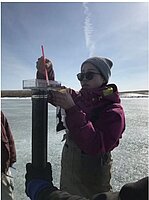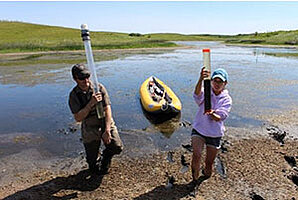Evaluating the Response of Diatoms and Cladocerans Communities to Climate Change over the Last Century in Lake P1, North Dakota

Kui Hu is a Ph.D. student in the Environmental Science and Conservation Program at North Dakota State University (NDSU). She holds a Bachelor’s Degree of Science in Geography and a Master’s Degree in Physical Geography from Yunnan Normal University, China.
Kui Hu is currently working with Dr. Jon Sweetman. She is interested in detecting the community changes and ecosystem resilience of lakes in response to anthropogenic disturbances and climatic change (especially the extreme drought events) through applying limnological and paleolimnological methods (i.e. diatoms, cladoceran, pigments, isotopes and geochemical proxies).
Email: kui.hu@ndus.edu
Phone: (701)-730-7146
Evaluating the Response of Diatoms and Cladocerans Communities to Climate Change over the Last Century in Lake P1, North Dakota
Prairie pothole wetlands play a significant role in providing important freshwater resources and vital ecosystem services in North Dakota, including habitat for waterfowl and other biodiversity, carbon sequestration and flood abatement. The climate in the Prairie Pothole Region (PPR) is highly variable, with multiyear periods of drought and periods of excess precipitation occurring over the past century, which have markedly influenced the wetland ecosystems. This study aims to evaluate the past climate change effects on biological assemblages (i.e., diatoms) in the prairie pothole wetland ecosystem by combining long-term historical meteorological datasets with sediment records from a prairie pothole lake. Initial results suggest that nutrient availability is the main factor that drives diatom assemblage changes over the past century. Diatoms in the sediment record show a shift from primarily benthic species to more planktonic taxa since 1966, which corresponds to the increased water levels in 1967-1972 (i.e., a relatively wetter period). These results imply that water level changes result in habitat changes due to climate change and can have important implications for biological community structure and wetland functioning. This research helps to test how the PPR’s primary producer communities have responded to changes in the frequency and duration of the wet and dry cycles. A clear understanding about the dynamics of the PPR wetland ecosystem in response to climate variability helps policy and decision makers propose appropriate management strategies to cope with the changing climate of the future.
Conference/Seminar Presentations:
Hu, K. 2018. A long term investigation of salinity change under a highly variable climate in North Dakota. 1st NDWRRI Special Water Resources Seminar. North Dakota State University, Fargo, ND (Oral Presentation).


Jon Sweetman
Biological Sciences
Office: Stevens 211A
Telephone: 701-231-8991
Email: jon.sweetman@ndsu.edu


